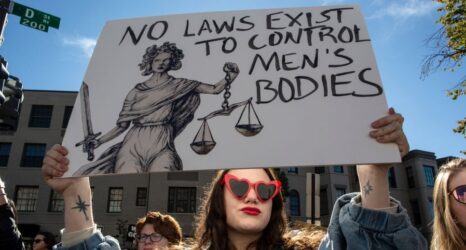Thousands of reproductive-rights advocates gathered outside of the Supreme Court today as the eight justices heard oral arguments in Whole Woman’s Health v. Hellerstedt, the biggest abortion-related case to go before the court since 1992.
The case centers around two provisions of Texas’ omnibus 2013 anti-abortion bill, HB2: one that requires abortion clinics to meet the building standards of ambulatory surgical centers—including specific hall widths and HVAC systems, for example—and another that requires doctors to have admitting privileges at a local hospital. Both provisions have been declared medically unnecessary by experts, despite the fact that anti-abortion legislators claim the restrictions ensure “quality of care” for women.
Said Nancy Northup, president and CEO of the Center for Reproductive Rights (CRR), “One thing was clear from the questions the justices asked today: that the facts are on the side of Whole Woman’s Health and the women of Texas. There is no justification for this law, even the American Medical Association and other leading medical providers have said that you cannot justify this for women’s health.” (Lawyers from CRR are arguing the case.)
Indeed, Justice Ruth Bader Ginsburg delivered a blow to Texas Solicitor General Scott Keller early in the day. As Slate reported, Ginsburg asked Keller how many women would be left without a clinic within 100 miles of where they live if HB2 is allowed to stand; 25 percent, he responded. That number includes women in the El Paso area, however, who would have to cross state lines into New Mexico to access care. Since the justices are weighing whether HB2’s restrictions impose an “undue burden” on a woman’s right to an abortion, and one of the state’s key justifications for HB2 is that its rules ensure women’s safety, Ginsburg pointed out the hypocrisy of sending women to another state that doesn’t require its clinics to meet the same standards.
“If your argument is right, then New Mexico is not an available way out for Texas, because Texas says: To protect our women, we need these things. But send [women in the El Paso area] off to New Mexico and that’s perfectly all right,” Ginsburg said. “If that’s all right for the women in the El Paso area, why isn’t it right for the rest of the women in Texas?” Keller failed to offer up a strong response.
Justice Anthony Kennedy is expected to be the swing vote in the case, inquiring today about the capacity of clinics that would remain open in Texas if HB2’s provisions are allowed to stand—about 10 facilities—and suggesting that perhaps the case should be returned to a lower court where attorneys can provide more evidence. Kennedy also asked about the implications of later-term abortions: Many Texas women have been forced to wait until the second trimester to end a pregnancy—a riskier procedure—because of HB2’s restrictions. According to the SCOTUSblog, “Kennedy cited data that the number of drug-induced abortions had increased nationally, but the number in Texas was down, and he commented that ‘this may not be medically wise.'”
The justices could return a decision as early as Monday, though earlier reports have suggested a decision won’t be made until June. They may decide to send the case back to a lower court, as Kennedy suggested.
In the meantime, advocates will continue fighting for reproductive rights and Texas’ remaining providers will continue to offer care.
Said Amy Hagstrom Miller, president and CEO of Whole Woman’s Health and lead plaintiff in the case, “Whole Woman’s Health v. Hellerstedt isn’t about one clinic or even one state—it is about every single one of us. We all should expect equality, dignity and justice in making our own health decisions. At Whole Woman’s Health we know we’re on the right side of history—and we’re hopeful that the court will be as well.”
Photo of supporters from across the country rallying at the Supreme Court courtesy of SKDKnickerbocker.





